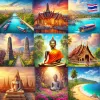Greetings, fellow globetrotters! Your intrepid American backpacking buddy is back, reporting live from the vibrant and surprisingly delicious city of Dongguan, nestled in the heart of Guangdong Province, China. Prepare yourselves for another epic tale of culinary conquests, cultural collisions, and communication calamities—because this Dongguan escapade was one for the ages!
Mythic Beasts and Three-Waters Wonders: A Wanjiang Introduction
My adventure began in Wanjiang, a district of Dongguan that immediately captivated me with its blend of ancient legends and modern bustle. The centerpiece of Wanjiang, at least for me, was the magnificent golden Ao Bao, a landmark structure with a story as rich and shimmering as its golden surface. Legend whispers that this impressive monument is the eldest son of the Dragon himself, a powerful guardian spirit tasked with protecting the waters of this unique three-river confluence. The sheer scale of the Ao Bao is impressive; standing beneath it, you feel a palpable sense of history and the enduring power of myth. This wasn't just a statue; it was a symbol of the area's history and the enduring importance placed on water management.
This three-river confluence isn't just a geographical quirk; it's a powerful force shaping the landscape and the lives of the people who call this place home. Three impressive bridges gracefully arch over the meeting point of these waters, a testament to the engineering prowess and the ongoing effort to harness the power of these rivers. I even witnessed a truly remarkable sight – an elderly gentleman taking a leisurely swim in the waters below. I'm not entirely sure if this was sanctioned by local authorities, but the scene spoke volumes about the relaxed and welcoming atmosphere of this place. It was a breathtaking scene, a perfect blend of nature's beauty and human resilience. The river, the bridges, and the old man swimming—it was a moment I won't soon forget. Wanjiang is a place where the old and the new blend seamlessly, where history whispers and modern life thrives.
A Culinary Hideaway: Hand-Made Beancurd in Wanjiang New Village
Leaving the realm of mythical beasts and magnificent structures, I delved into the heart of Wanjiang New Village, where I stumbled upon a culinary treasure – a tiny restaurant tucked away in a narrow, almost hidden alleyway. The aroma alone was enough to stop me in my tracks—the rich, smoky scent of charcoal fire hung heavy in the air, promising culinary delights. This was the 千機圓鍋 (Qiānjī yuán guō), a family-run establishment specializing in hand-made beancurd sheets and soy milk, and it was about to become my favorite place in Dongguan.
The owner, a charming and incredibly hardworking woman, greeted me with a warm smile and immediately began to demonstrate her craft. The process was mesmerizing; watching her expertly manipulate the beancurd, coaxing out delicate sheets, was a testament to years of practice and honed skill. I learned that this was a multi-generational family business, passed down through generations, a testament to the enduring power of family traditions and culinary craftsmanship. This wasn’t just about making beancurd; it was about preserving a heritage.
Here's a closer look at the culinary wonders I encountered:
| Item | Description |
|---|---|
| Hand-Made Beancurd Sheets | Thin, delicate sheets of beancurd, meticulously crafted and slowly dried over a charcoal fire, imparting a unique smoky flavor. |
| Traditional Soy Milk | Rich, creamy soy milk, cooked in the traditional manner over a charcoal fire, lending a subtle smoky depth to the flavor. |
| Roasted Beancurd Residue | Don't dismiss the humble beancurd residue! Surprisingly delicious when roasted, offering a nutty, earthy flavor. |
The sheer artistry and dedication involved in creating these beancurd sheets are truly awe-inspiring. The slow, deliberate process, the careful attention to detail—it's a testament to a commitment to quality that's sadly rare these days. The subtle smoky flavor from the charcoal fire adds a unique touch that elevates these simple ingredients to something truly special.
A Dongguan Breakfast to Remember: Beyond Beancurd
My culinary journey didn't end with the beancurd. I had to experience a true Dongguan breakfast, and the result was a symphony of flavors that danced on my palate. The star of the show was the soy milk, rich and creamy, with a delicate layer of beancurd floating on top. This was accompanied by crispy, golden-brown 油條 (youtiao)—deep-fried dough sticks—and a perfectly cooked egg, all infused with that magical smoky aroma from the charcoal fire. The simplicity of this breakfast belied its profound deliciousness. It was a culinary revelation, proving that sometimes, the most unforgettable meals are the simplest. Forget fancy restaurants and Michelin stars; this was a breakfast worthy of a Michelin-starred chef. This humble combination was, without a doubt, superior to any lobster or caviar I've ever tasted. The sheer harmony of the flavors, textures, and aromas was a truly unforgettable experience.
A Fortifying Broth: The Bull Penis Soup Experience (and Other Delights)
Next on my culinary adventure was a dish that required a bit more courage: 牛鞭湯 (niúbiān tāng)—bull penis soup. Now, I'm not one to shy away from a culinary challenge, but even I needed a moment to mentally prepare myself. I approached it with a sense of adventurous curiosity, and the experience was certainly...memorable.
I paired the soup with some delectable steamed oysters—perfectly plump and juicy—and a bowl of spicy, flavorful noodle soup with spare ribs. The bull penis soup itself had a surprising subtlety. It was more like a rich beef broth infused with a hint of medicinal herbs. It wasn't something I'd crave daily, but it certainly added a unique chapter to my Dongguan food diary. The oysters were a revelation of freshness and sweetness, and the noodle soup was a comforting explosion of flavor and spice. And of course, no Dongguan culinary exploration would be complete without the 龍舟飯 (lóngzhōu fàn)—Dragon Boat rice—a celebratory feast traditionally consumed during the Dragon Boat Festival. The sticky rice, infused with the flavors of seafood, cured meats, and an array of vegetables, was an explosion of tastes and textures, a truly unforgettable culinary experience. The savory-sweet balance was impeccable, and the overall experience was a testament to the culinary artistry of the region.
Sweet Endings and Afternoon Delights: A Taste of Italy in Dongguan
No culinary journey is complete without a touch of sweetness, and Dongguan did not disappoint. I discovered a charming Italian-themed dessert shop—yes, you read that right!—offering a delightful range of pastries and refreshing beverages. It was a surprising but welcome juxtaposition of cultures, offering a delightful blend of Eastern and Western culinary traditions. I indulged in several delectable treats, including delicate pastries, creamy cakes, and refreshing fruit-infused drinks, ending my day on a truly sweet note. This unexpected encounter only served to reinforce the unique and eclectic nature of Dongguan.
Dongguan: A City of Unexpected Delights and Culinary Adventures
Dongguan has exceeded all my expectations. It’s a city that seamlessly blends ancient legends and modern life, offering a fascinating tapestry of experiences. From the mythical Ao Bao guarding the three-river confluence to the hidden culinary treasures tucked away in its alleyways, Dongguan is a city that rewards the curious traveler. The warmth and friendliness of the locals, the diversity of the cuisine, and the rich cultural heritage make it a truly unforgettable destination. Until next time, happy travels!







